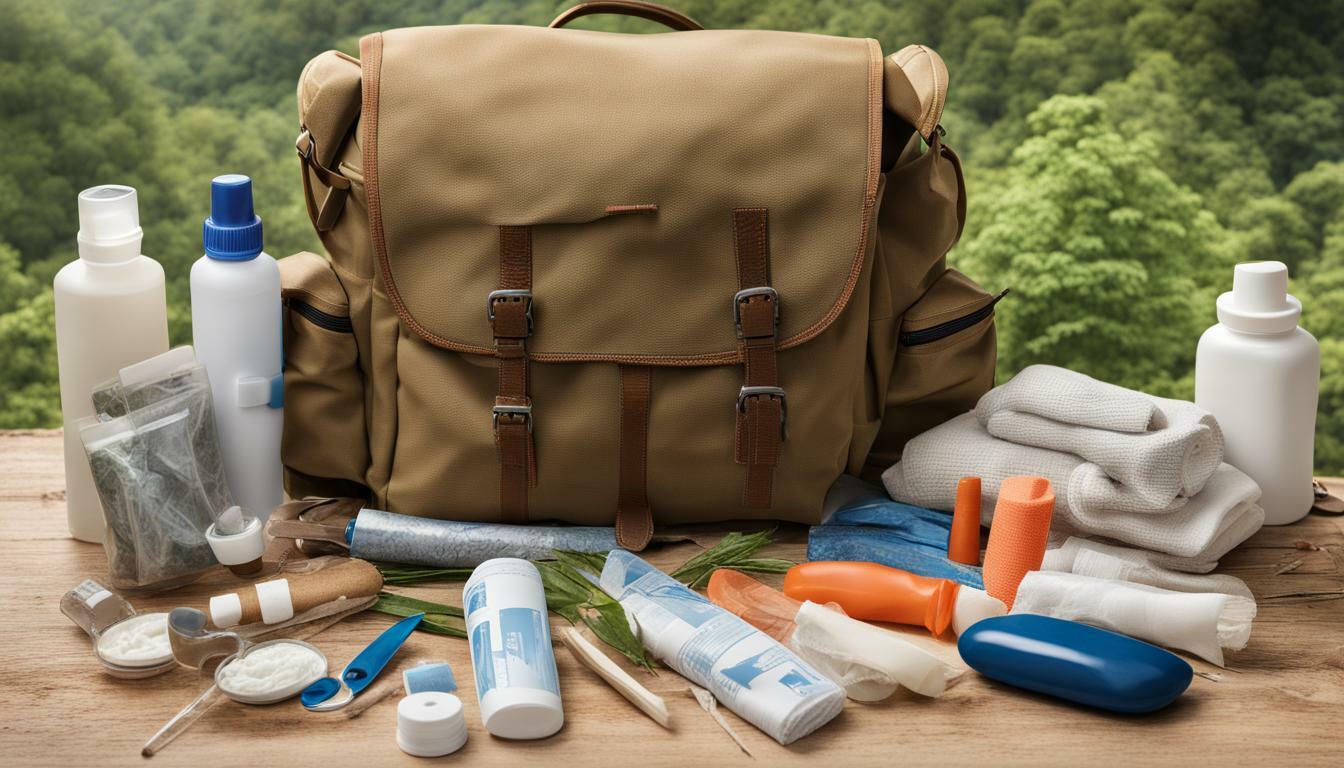When heading out for outdoor adventures like hiking and camping trips, it’s crucial to be prepared for emergencies. One way to ensure wilderness safety is by carrying a well-stocked first aid kit. Essential first aid items can make a difference in an emergency and help prevent minor injuries from becoming major ones.
From bandages and antiseptics to medications and tools, a comprehensive emergency medical kit can provide peace of mind while exploring the great outdoors. In this article, we’ll explore the essential first aid items that should be part of your hiking gear and camping essentials.
Key Takeaways
- Being prepared for emergencies while on hiking and camping trips is crucial for wilderness safety.
- A well-stocked first aid kit can help prevent minor injuries from becoming major ones.
- Essential first aid items like bandages, antiseptics, medications, and tools should be included in the kit.
Why is First Aid Important for Hiking and Camping Trips?
When it comes to outdoor adventures like hiking and camping, being prepared for emergencies is crucial. Accidents can happen when we least expect them, especially in the wilderness where we are exposed to various hazards. That’s why carrying an emergency medical kit is essential for wilderness safety.
Even minor wounds or injuries can escalate quickly in the wilderness, making it important to have the right tools and knowledge to handle them. An emergency medical kit containing the necessary first aid supplies and medications can help manage common ailments and provide immediate relief in case of an emergency.
Moreover, having a well-stocked emergency medical kit can also be reassuring and give you peace of mind during your trip. You can focus on enjoying the outdoor adventure without worrying about the what-ifs.
Overall, carrying a first aid kit is an important aspect of being a responsible hiker or camper. It can be the difference between a small mishap and a more serious situation, making it a must-have in your hiking gear or camping essentials.
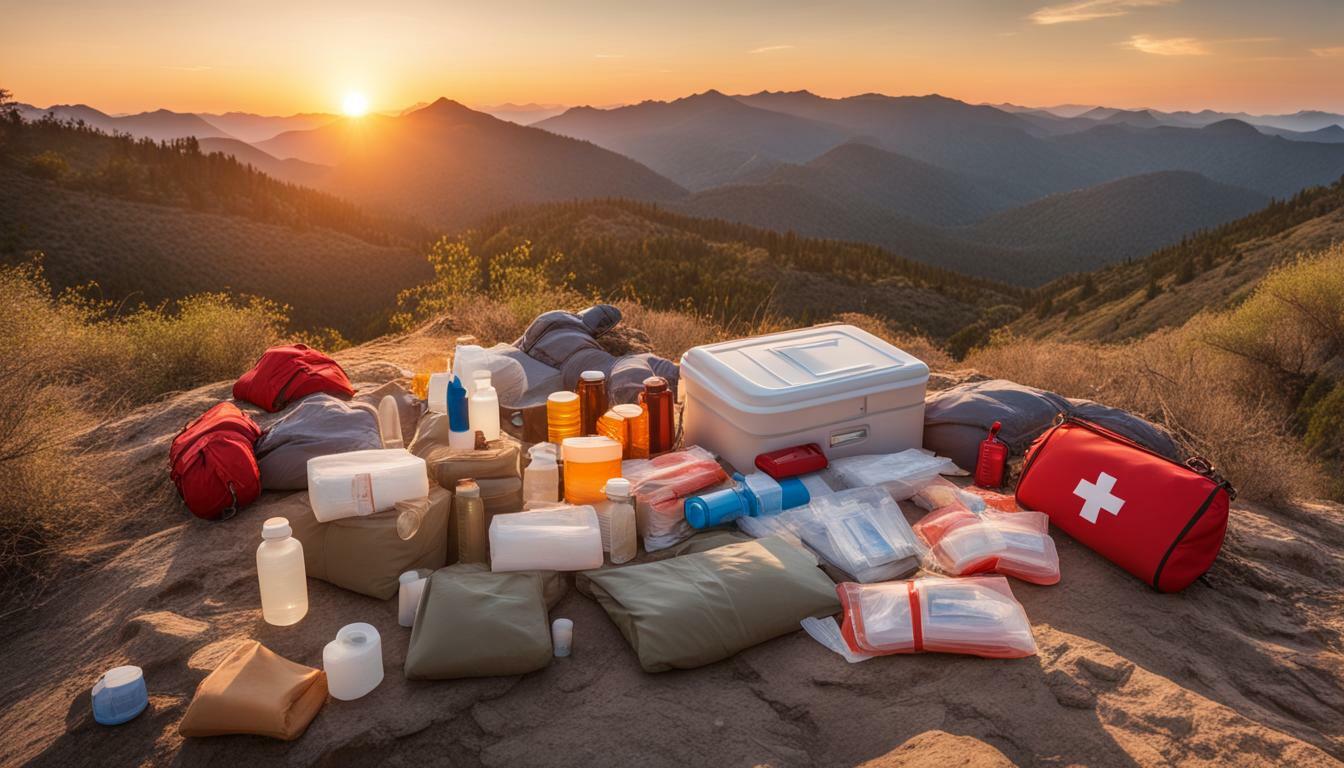
Creating an Emergency Medical Kit
When it comes to wilderness safety, having a well-stocked emergency medical kit is crucial for any outdoor adventure, including hiking and camping trips. Being prepared with the right first aid supplies can make a significant difference in an emergency situation and can potentially save a life. Here are the essential first aid supplies that should be in your emergency medical kit for hiking and camping trips:
| First Aid Supplies | Use |
|---|---|
| Bandages | Used to cover and protect wounds |
| Gauze Pads | Used to stop bleeding and clean wounds |
| Adhesive Tape | Used to secure bandages and dressings |
| Tweezers | Used to remove splinters and small foreign objects from wounds |
| Scissors | Used to cut bandages and clothing in the case of an emergency |
| Antiseptic Wipes | Used to clean wounds and prevent infection |
| Disinfectants | Used to clean and sterilize tools and instruments |
| Pain Relievers | Used to alleviate pain and reduce inflammation |
| Medications | Used to manage common ailments, such as allergies and insect bites |
| Splints | Used to immobilize broken bones and sprains |
| Thermometer | Used to monitor body temperature and detect fever or hypothermia |
| Safety Pins | Used to secure bandages and clothing or improvise a sling or splint in the case of an emergency |
| Emergency Contact Information | Include important phone numbers, such as emergency services and local healthcare providers |
It’s important to organize and pack the emergency medical kit in a way that makes it easily accessible in the case of an emergency. Consider packing items in clearly labeled zip-lock bags or waterproof containers to keep them dry and organized. Additionally, it’s essential to check the expiration dates of all medications and supplies regularly and replace any used or expired items as soon as possible.
An emergency medical kit can be the difference between life and death, and being prepared for any situation can give you the peace of mind to enjoy your hike or camping trip to the fullest. Keep in mind that this is not an exhaustive list, and hikers and campers should tailor their emergency medical kit based on their specific needs and the nature of their outdoor activities.
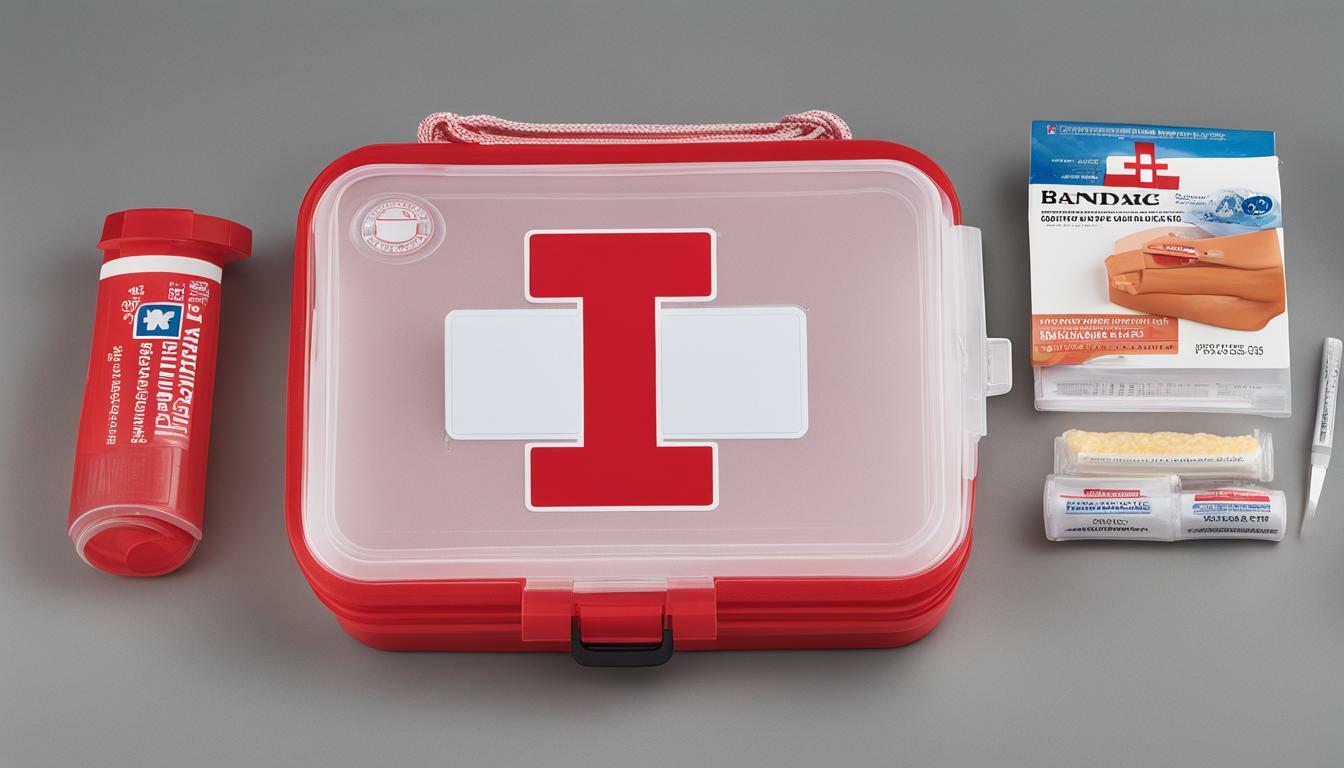
Bandages and Dressings
Carrying various types of bandages and dressings in your first aid kit is crucial for dealing with cuts, scrapes, and other injuries that may occur during hiking and camping trips. Adhesive bandages, also known as plasters, are a must-have for minor cuts and blisters. Gauze pads are perfect for covering larger wounds and preventing infection.
Elastic bandages are useful for treating sprains and strains, providing compression and support to the affected area. Additionally, triangular bandages can be used to immobilize broken bones or create a sling for an injured arm or shoulder.
Remember to pack enough bandages and dressings to last for the duration of your trip. It’s better to have more than you think you’ll need, as injuries can happen unexpectedly and you don’t want to run out of supplies.
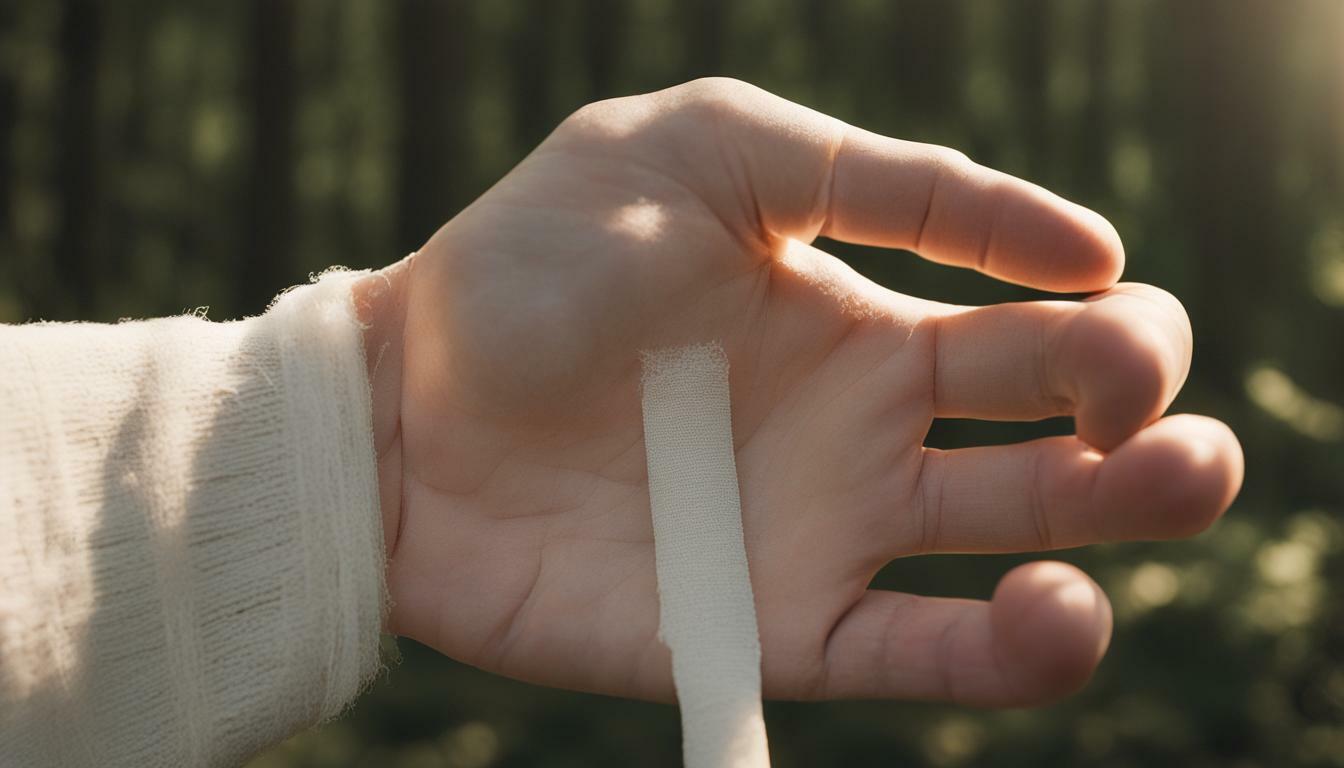
Proper usage of bandages and dressings is also important. Make sure to clean the wound before applying any dressing and change it regularly to avoid infections.
Types of Bandages and Dressings
| Bandage Type | Uses |
|---|---|
| Adhesive Bandages | Minor cuts and blisters |
| Gauze Pads | Large wounds and bleeding |
| Elastic Bandages | Sprains and strains |
| Triangular Bandages | Immobilizing broken bones and creating a sling |
Make sure to check the expiration dates on your bandages and dressings regularly and replace any that have expired. Keeping your first aid supplies up-to-date and well-stocked will ensure you’re always prepared for any wilderness emergency.
Antiseptics and Disinfectants
When hiking or camping, it is important to have antiseptics and disinfectants in your first aid kit. These essential first aid supplies can help to prevent infection and promote healing in case of an injury.
Common examples of antiseptics include hydrogen peroxide and iodine. It is important to follow proper guidelines for their use, as overuse can lead to skin irritation. Affected areas should be cleaned thoroughly with an antiseptic solution before applying any bandages or dressings.
Insect bites and stings are common occurrences during outdoor activities, and they can lead to infection if not treated properly. Applying an antiseptic can help prevent swelling and further complications.
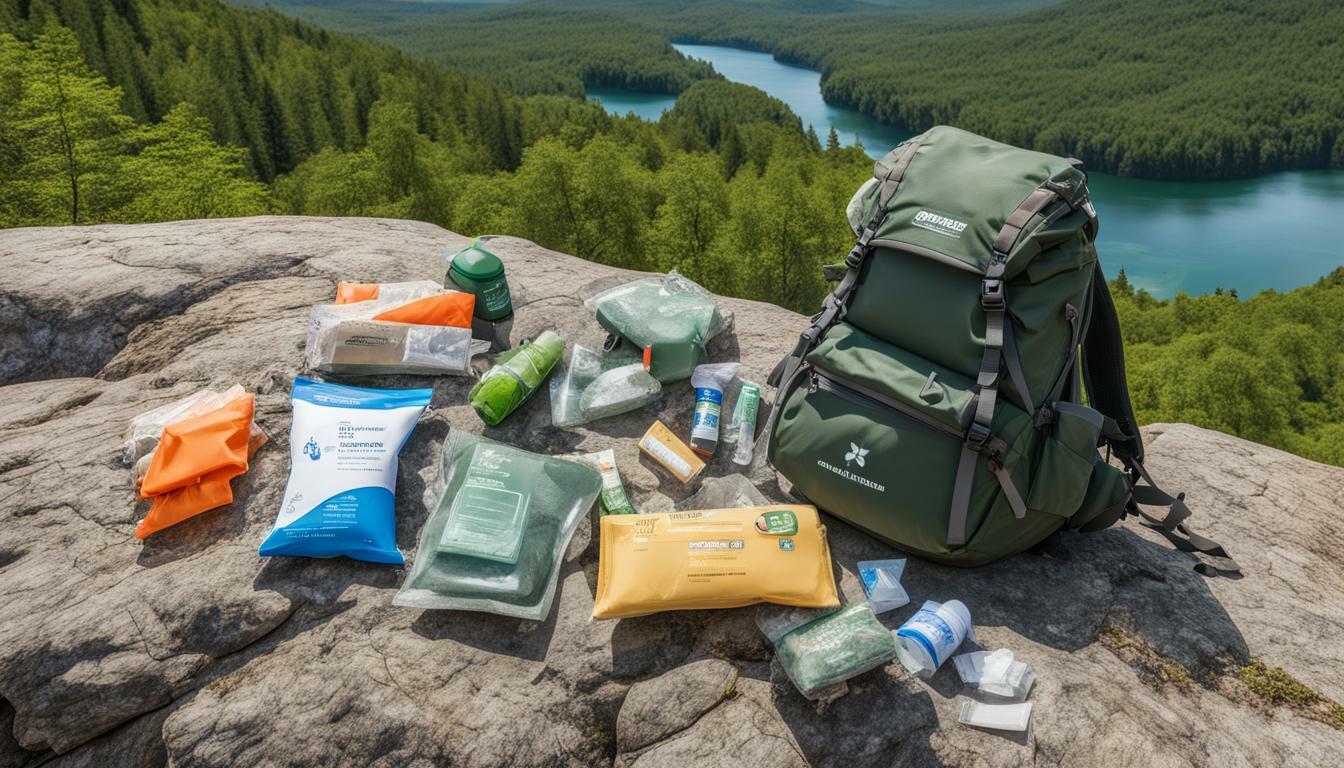
It is important to remember that while antiseptics can help with initial wound care, they cannot replace proper medical attention. If you experience signs of infection, such as fever, chills, or pus discharge, seek medical help immediately.
As with all medications and emergency medical kit supplies, make sure to check the expiration dates and replace any used or expired items. Proper maintenance of your first aid kit can make all the difference in staying safe and prepared during your wilderness adventures.
Pain Relievers and Medications
Carrying pain relievers and necessary medications in your first aid kit is crucial for a safe and enjoyable hiking or camping trip. Pain relievers can help alleviate discomfort caused by headaches, sprains, and other minor injuries that can occur during outdoor activities. Including medications for common ailments like colds, allergies, or stomach issues can also prevent a minor health issue from turning into a major problem.
When packing medications, it’s important to ensure they are in their original packaging and properly labeled. Include only the necessary amount of medication, as carrying excessive amounts may add unnecessary weight to your hiking gear or camping essentials. Keep in mind that some medications may require specific storage conditions, so be sure to read the labels and pack accordingly.
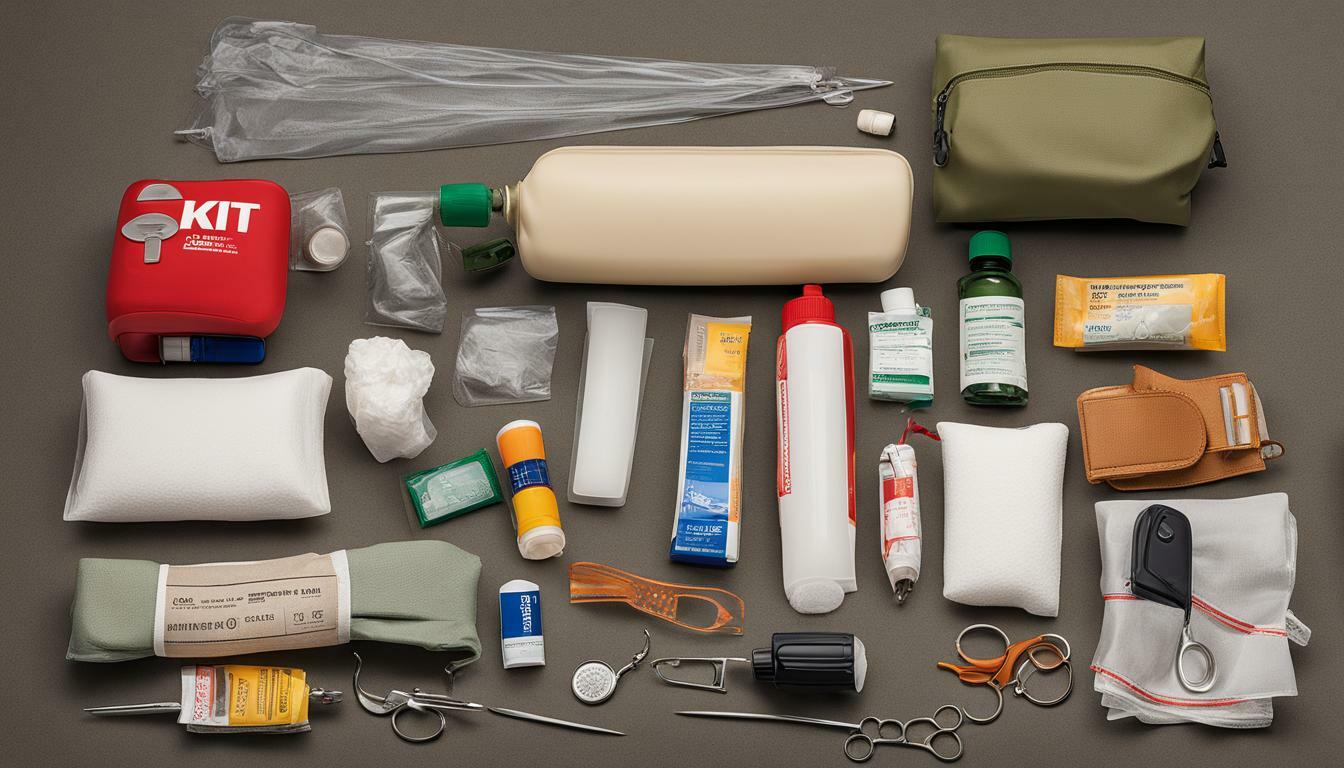
To further prepare for emergencies, consider including a small first aid manual in your kit. This resource can provide guidance on how to use the included supplies and how to respond to common medical situations. Additionally, it’s essential to have a detailed list of any medical conditions or allergies of those in your hiking or camping group in case of an emergency.
Tools and Instruments
Aside from the essential first aid supplies, it is also important to pack necessary tools and instruments for handling medical situations in the wilderness. A well-stocked emergency medical kit should include the following:
| Item | Use |
|---|---|
| Tweezers | For removing splinters, ticks, and other small objects from the skin. |
| Scissors | For cutting bandages, tape, and other medical supplies. |
| Thermometer | For monitoring body temperature, especially in cases of fever or hypothermia. |
| Safety Pins | For securing bandages and dressings in place. |
Having these tools and instruments on hand can make a big difference in emergency situations when quick and precise action is necessary.
It is also important to note that outdoor activities like hiking and camping may require specialized instruments to manage specific injuries. For example, carrying a snakebite kit if you’re going to be in an area known for venomous snakes. Plan ahead by researching the area where you will be traveling and pack accordingly.

By being prepared with the right first aid supplies, tools, and instruments, you can enjoy your hiking and camping trips with the peace of mind that you are ready for any medical situation that may arise.
Medications for Allergies and Insect Bites
When it comes to hiking and camping trips, encountering allergens and insects is almost inevitable. That’s why it’s crucial to include medications for allergies and insect bites in your first aid kit.
Antihistamines are an essential medication for treating allergic reactions caused by insect bites, plants, or food. They work by blocking histamine, which causes discomfort, itchiness, and swelling. Benadryl is a common antihistamine that can help relieve mild to moderate allergic reactions. Consult with your doctor or pharmacist for the best advice on which antihistamines to include in your first aid kit.
Epinephrine auto-injectors should be carried if you have a known history of severe allergic reactions, also known as anaphylaxis. Common brands include EpiPen and Anapen. These devices deliver a dose of epinephrine, which can help counteract life-threatening symptoms like difficulty breathing, throat swelling, and low blood pressure.
Don’t let allergies and insects ruin your outdoor activities. Be prepared and pack the necessary medications for allergies and insect bites in your emergency medical kit.
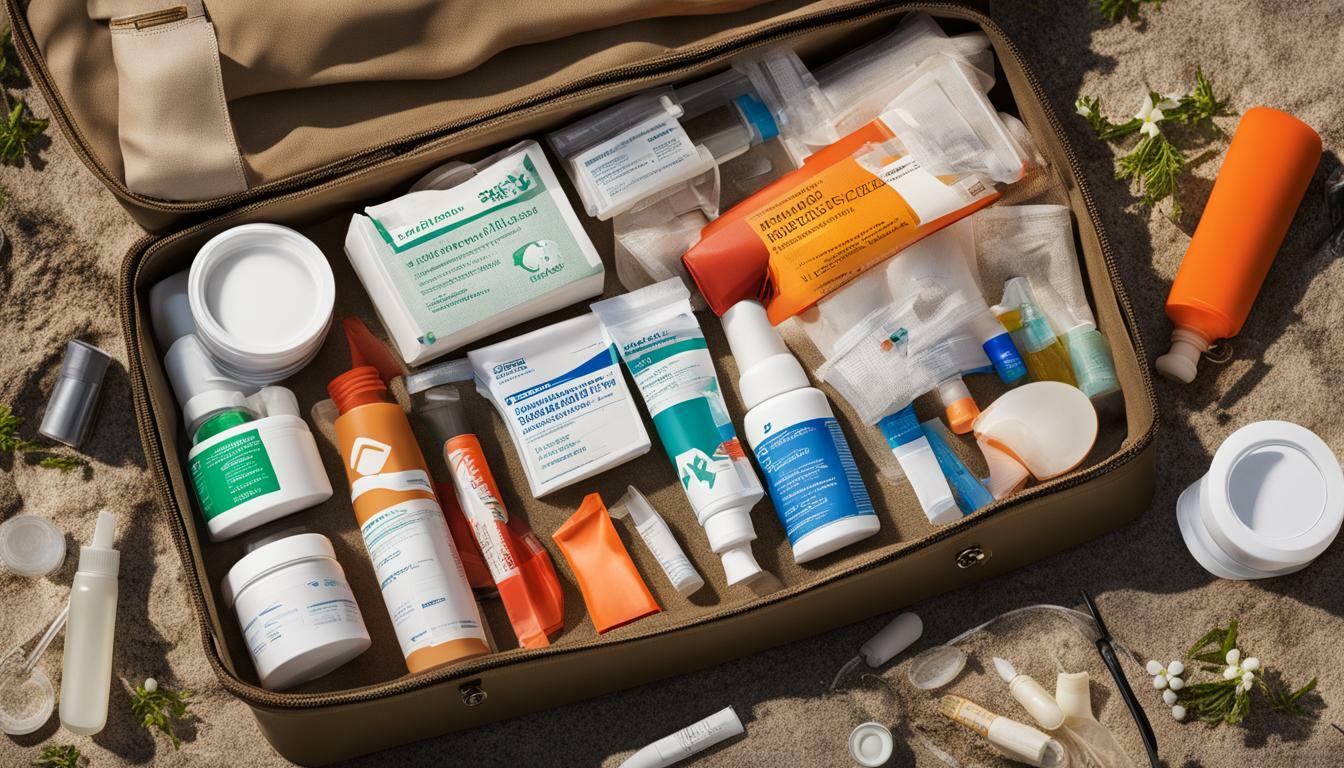
Next in our essential first aid items for hiking and camping trips is the consideration of other items you may need in your first aid kit.
Other Essential Items
In addition to the first aid supplies mentioned earlier, there are a few other essential items that are important for a well-stocked emergency medical kit for hiking and camping trips.
| Item | Purpose |
|---|---|
| Adhesive tape | Used to secure dressings and bandages in place and provide support to injured joints. |
| Splints | Used to immobilize broken bones or sprained joints until medical help arrives. |
| Eye wash solution | Used to irrigate the eyes in case of injury or exposure to foreign substances. |
| Emergency contact information | Include important phone numbers, such as emergency services, park rangers, and personal contacts, in case of an emergency. |
Carrying these items in the first aid kit can make all the difference in an emergency situation. You never know when you might need them, so it’s best to be prepared.
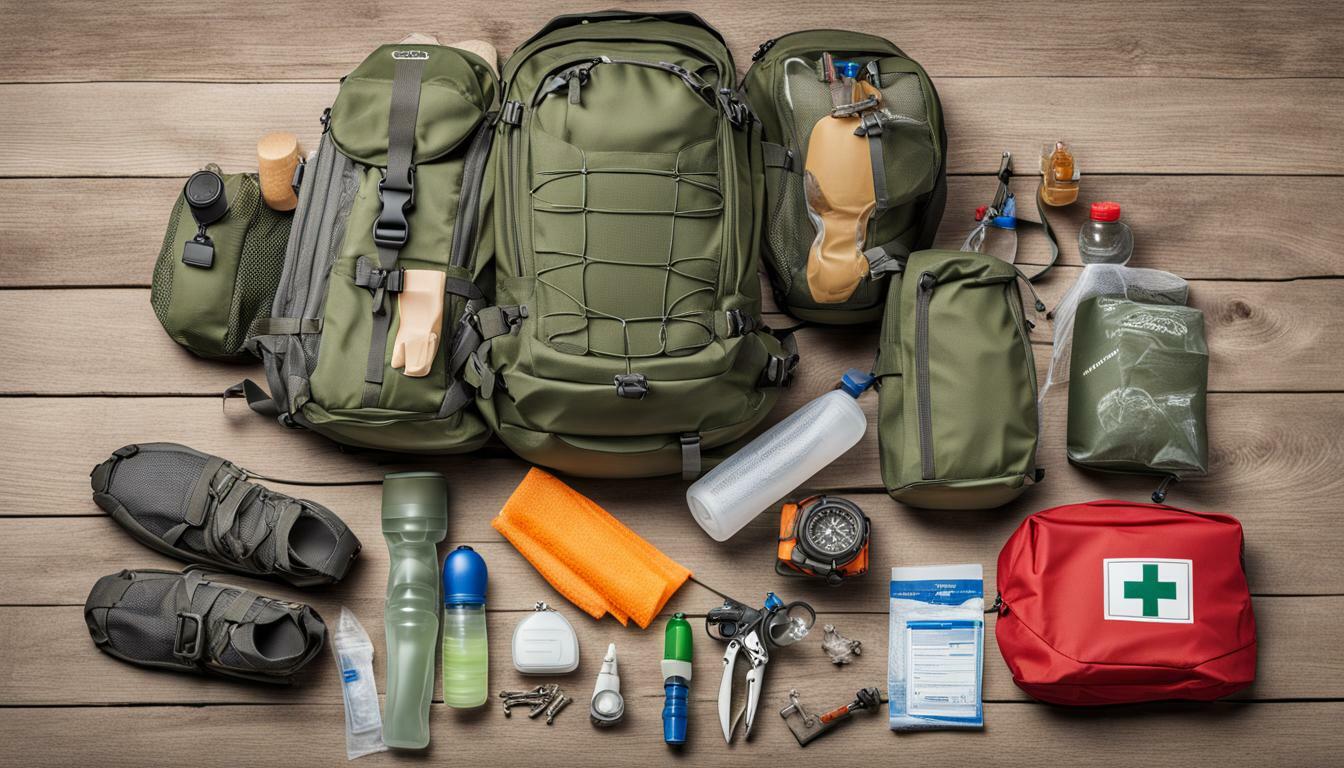
Make sure to pack these essential first aid supplies, along with the other items discussed earlier, in your hiking gear and camping essentials. Keeping the emergency medical kit well-stocked and organized is crucial for wilderness safety and enjoying outdoor activities to the fullest.
Maintaining and Restocking Your First Aid Kit
A well-stocked and organized first aid kit is an essential item for any hiking and camping trip. However, it’s important to note that the supplies in your kit will eventually run out or expire, and it’s crucial to restock and update it regularly.
Here are some tips on how to maintain and restock your first aid kit:
Regularly check expiration dates
Many items in your first aid kit, such as medications and ointments, have an expiration date. It’s important to check these regularly to ensure that your supplies are still effective and safe for use. Replace any expired items promptly.
Replace used items
If you’ve used any items from your first aid kit during your trip, make sure to replace them before your next excursion. It’s essential to have a fully stocked kit at all times, so you’re prepared for any emergency situation.
Consider the season
Depending on the time of year and location of your trip, you may need to adjust the contents of your first aid kit. For example, you may need to add insect repellent or additional sun protection during the summer months.
Pack wisely
When packing for your trip, consider the length and difficulty of your hike or camping trip, and pack accordingly. Make sure your first aid kit is easily accessible and in a waterproof container.
By following these tips and ensuring that your first aid kit is always fully stocked and up to date with essential supplies, you’ll be better prepared to handle any emergency situation that may arise during your hiking and camping adventures.
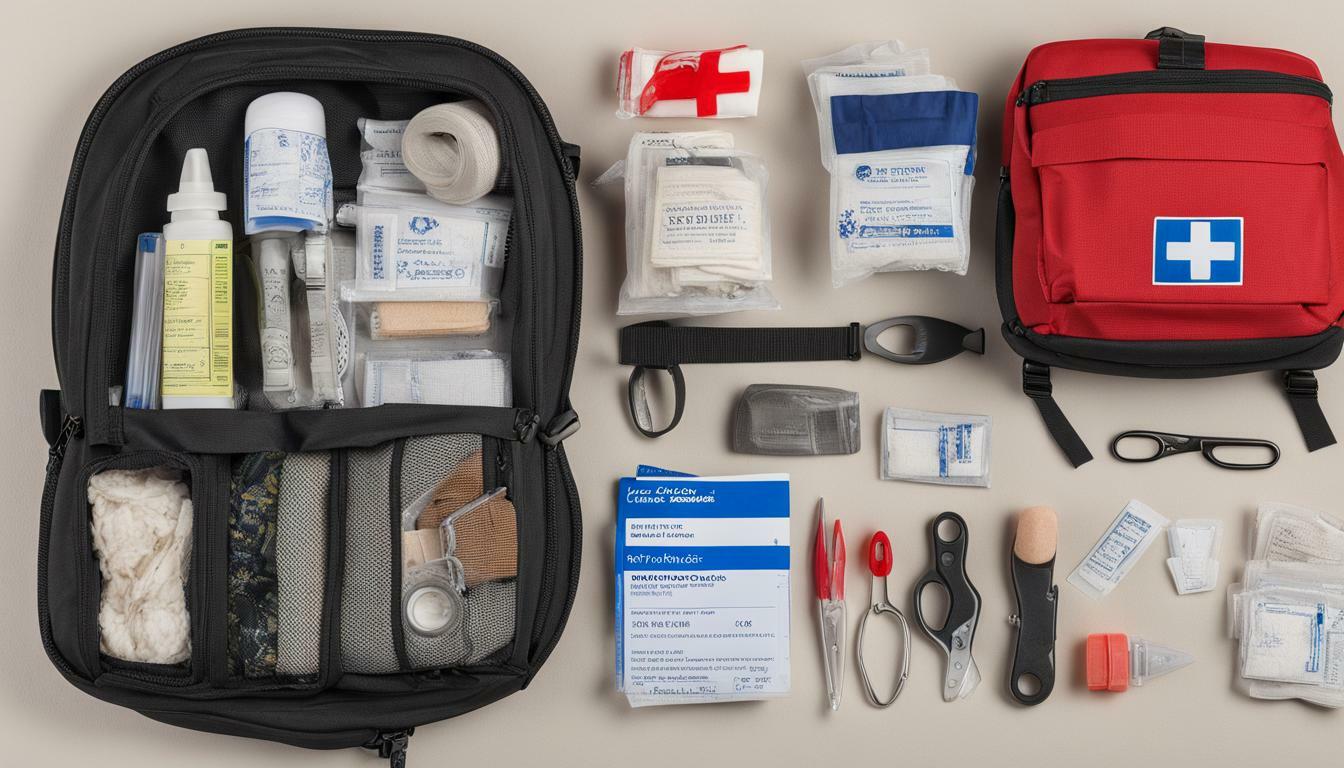
First Aid Training and Resources
While carrying essential first aid items is crucial for wilderness safety during hiking and camping trips, it is equally important to have the necessary knowledge and skills to use them effectively. First aid training can provide you with the confidence and ability to handle various medical situations that may arise in the outdoors.
There are several resources available for those who want to learn basic first aid techniques. Online courses, like those offered by St John Ambulance and the Red Cross, are convenient and accessible. They provide step-by-step instructions and interactive simulations to help you learn how to respond to emergencies.
Additionally, local training centers and community organizations often offer first aid training courses. These courses may be more comprehensive and hands-on, allowing you to practice first aid techniques in a controlled environment.
By taking a first aid course and staying up-to-date on the latest techniques and procedures, you can better ensure your safety and the safety of those around you during outdoor activities.
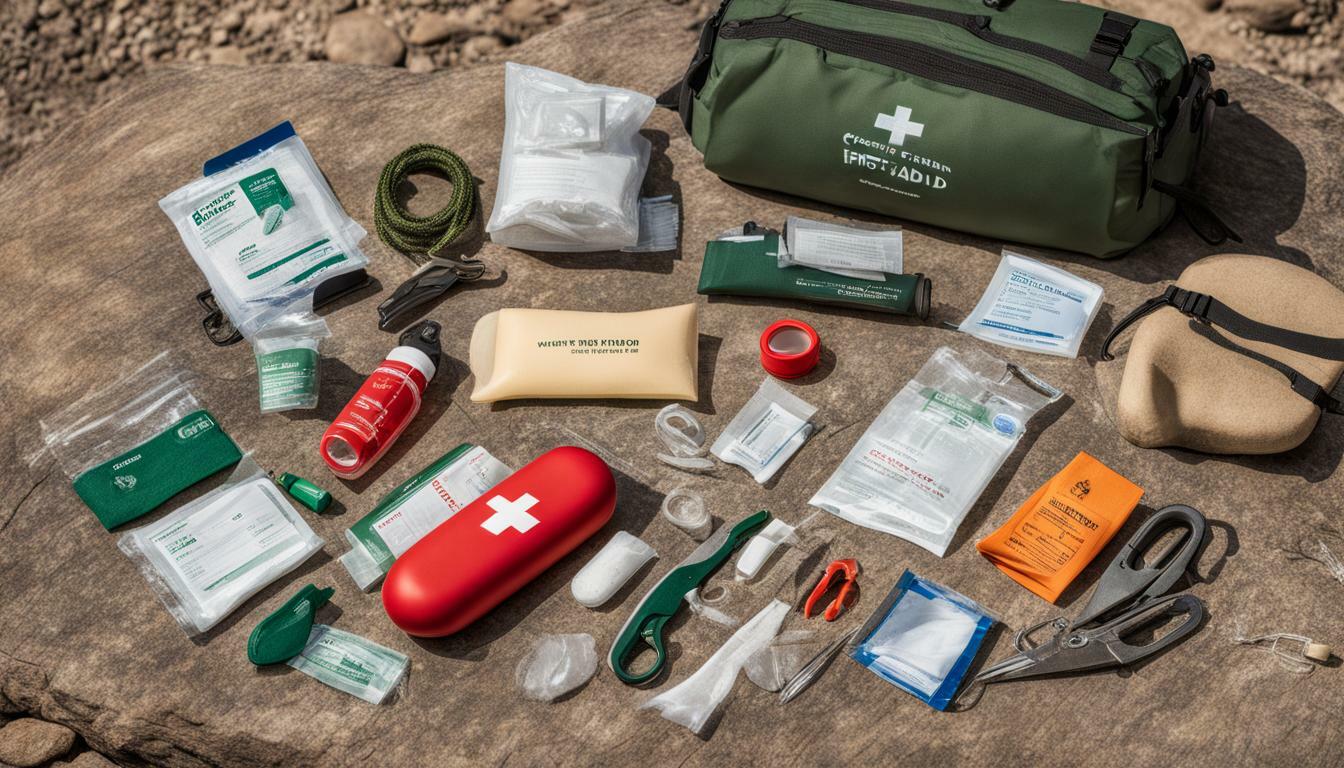
Conclusion
In summary, packing essential first aid items for your hiking and camping trips is crucial for your safety and well-being. Emergencies can happen at any time, and being prepared with a well-stocked emergency medical kit can make all the difference. Remember to include bandages and dressings, antiseptics and disinfectants, pain relievers and medications, tools and instruments, allergy and insect bite medications, and other essential items in your first aid kit.
Maintaining and restocking your first aid kit regularly is also important to ensure that it is always ready for your outdoor adventures. Remember to check expiration dates and replace used items promptly. Additionally, it is wise to consider getting first aid training to learn basic first aid techniques and become better equipped to handle emergencies in the wilderness.
We hope this guide has been helpful in preparing you for your hiking and camping trips. Remember to pack wisely and enjoy outdoor adventures responsibly. Stay safe and have fun!
